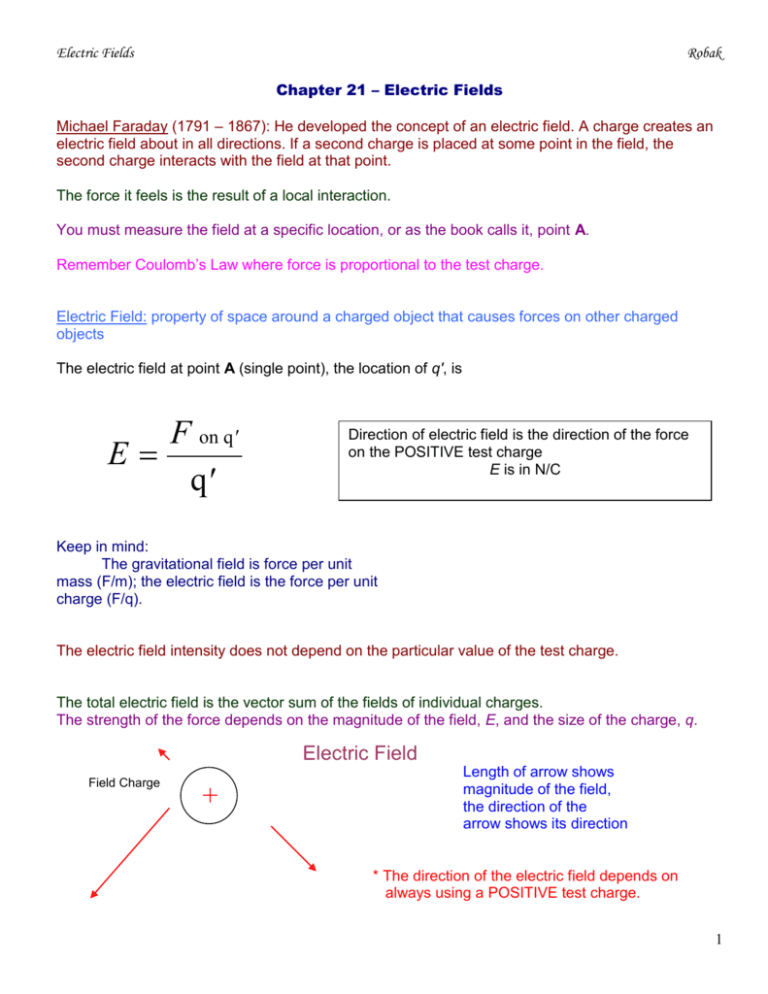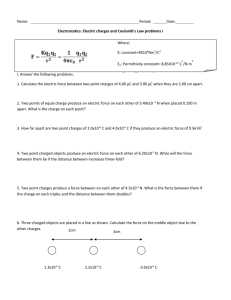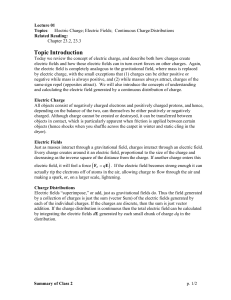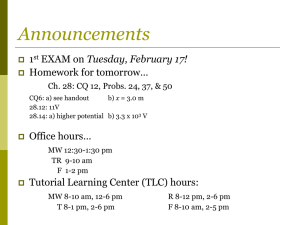Electric Fields
advertisement

Electric Fields Robak Chapter 21 – Electric Fields Michael Faraday (1791 – 1867): He developed the concept of an electric field. A charge creates an electric field about in all directions. If a second charge is placed at some point in the field, the second charge interacts with the field at that point. The force it feels is the result of a local interaction. You must measure the field at a specific location, or as the book calls it, point A. Remember Coulomb’s Law where force is proportional to the test charge. Electric Field: property of space around a charged object that causes forces on other charged objects The electric field at point A (single point), the location of q′, is F on q E q Direction of electric field is the direction of the force on the POSITIVE test charge E is in N/C Keep in mind: The gravitational field is force per unit mass (F/m); the electric field is the force per unit charge (F/q). The electric field intensity does not depend on the particular value of the test charge. The total electric field is the vector sum of the fields of individual charges. The strength of the force depends on the magnitude of the field, E, and the size of the charge, q. Electric Field Field Charge + + + Length of arrow shows magnitude of the field, the direction of the arrow shows its direction * The direction of the electric field depends on always using a POSITIVE test charge. 1 Electric Fields Robak Question to think about: There is an electric field at the surface of Earth of about 150 N/C. Its direction is downward. What can you tell me about Earth’s charge? Picturing the electric field Electric field lines: lines representing the direction of electric field. The direction of the field at any point is the tangent drawn to the field line at that point. The strength of the electric field is indicated by the spacing between the lines. Field is strong where the lines are close together, and weaker when lines are spaced farther apart. Electric fields exist in 3-d, we use 2-d. Positive test charge: direction of force on positive test charge near a positive charge is away from charge. Field lines extend radially outward. Negative test charge: direction of force on positive test charge is toward charge. Field lines point radially inward. 2 Electric Fields Robak If there are 2 or more charges, the field is the vector sum of the fields due to the individual charges – field lines become curved * Field lines always leave a positive charge and enter a negative charge An electric field points away from positive charges and toward negative charges An electric field is produced by one or more charges and is independent of the existence of the test charge that is used to measure it. The field provides a method of calculating the force on a charged body Electric fields are real. Electric field lines are imaginary, but help in making a picture of the field. Applications of the Electric Field We are only concerned with charges at rest, or changes in Potential Energy (PE). Work is needed to move an object against gravity – you lift a ball, you do work, and its PE is increased. Same situation w/2 unlike charges – they attract, so you must do work to pull one away from the other. The larger the test charge, the greater the increase in its PE. Remember from last time: The field is the force per unit charge, or F q . Electric potential difference: change in potential energy divided by the charge V PE q unit is Joule/Coulomb = volt (J/C = V) 3 Electric Fields Robak B + E Increase in Electric PE + A You do work when moving test charge from A to B (against electric force). Increase in PE, so positive change in PE – Electric Potential is positive. When moving from B to A, EF does work on you, PE is reduced, and Electric Potential is negative. The work done on you returning the charge is equal and opposite to the work you do moving it away, hence The Electric Potential difference between A & B is equal and opposite to the difference between B & A. Net change in potential from A to B to A is ZERO. Potential of point A depends only on its position, not on the path taken to get there. Electric Potential Difference (voltage): V = VB – VA, usually measured with a voltmeter Choose a reference point: Point A: then VA = 0, and VB = V Point B: then VB = 0, and VA = -V *The value of potential difference will always be the same. 4 Electric Fields Robak If there are 2 like charges ( + and + ), then there is a repulsive force, PE decreases as the 2 charges move apart, therefore electric potential is smaller. A constant electric force and field can be made by placing 2 large flat conducting plates parallel to each other: one + charged, one – charged. The electric field is constant (uniform) between plates. Electric field between 2 parallel plates is uniform only if the length and width of the plates is much larger than their separation. The potential difference, V, between 2 points a distance d apart in a uniform field E, is V = Ed Units are (N/C) · m = J/C = volt Potential is higher near the positively charged plate A step further: F E q Kqq d q Kq d W qV (Work done moving a charge from one plate to another) Millikan’s Oil Drop Experiment One important application of the uniform electric field between 2 parallel plates was the measurement of the charge of an electron, which was made by Robert A. Millikan (1868 – 1953). In his experiment, a drop is suspended if the electric and gravitational forces are balanced. 5 Electric Fields Robak He noted changes in the charges (the oil drops had multiple varieties of charges) were always a multiple of -1.6 x 10-19 C, caused by one or more electrons being added or removed from the drops. • Millikan says that each electron carried a charge of -1.6 x 10-19 C. • An object can have only one charge with a magnitude that is some integral multiple of the charge of the electron (charge is quantized). Sharing of Charge Charges move until all parts of a conductor are at the same potential. If a large and small sphere have the same charge, the large sphere will have a lower potential because charges can spread farther apart on a larger sphere. If the two spheres are touched together, charges will move to the sphere with the lower potential, or the smaller to the larger sphere. Result: greater charge on the large sphere when 2 different-sized spheres are at the same potential. Touching an object to Earth to eliminate excess charge is grounding. 6 Electric Fields Robak The electric field around a conducting body depends on the structure and shape of the body. Capacitance is the ratio of charge stored to potential difference. Capacitors store energy in the electric field between two charged conductors which is separated by an insulator. Capacitance can be measured by placing charge q on one plate and –q on the other and measuring the potential difference, V. q C V Capacitance is measured in farads, F, named after Michael Faraday. One farad is one coulomb per volt (C/V). 7








